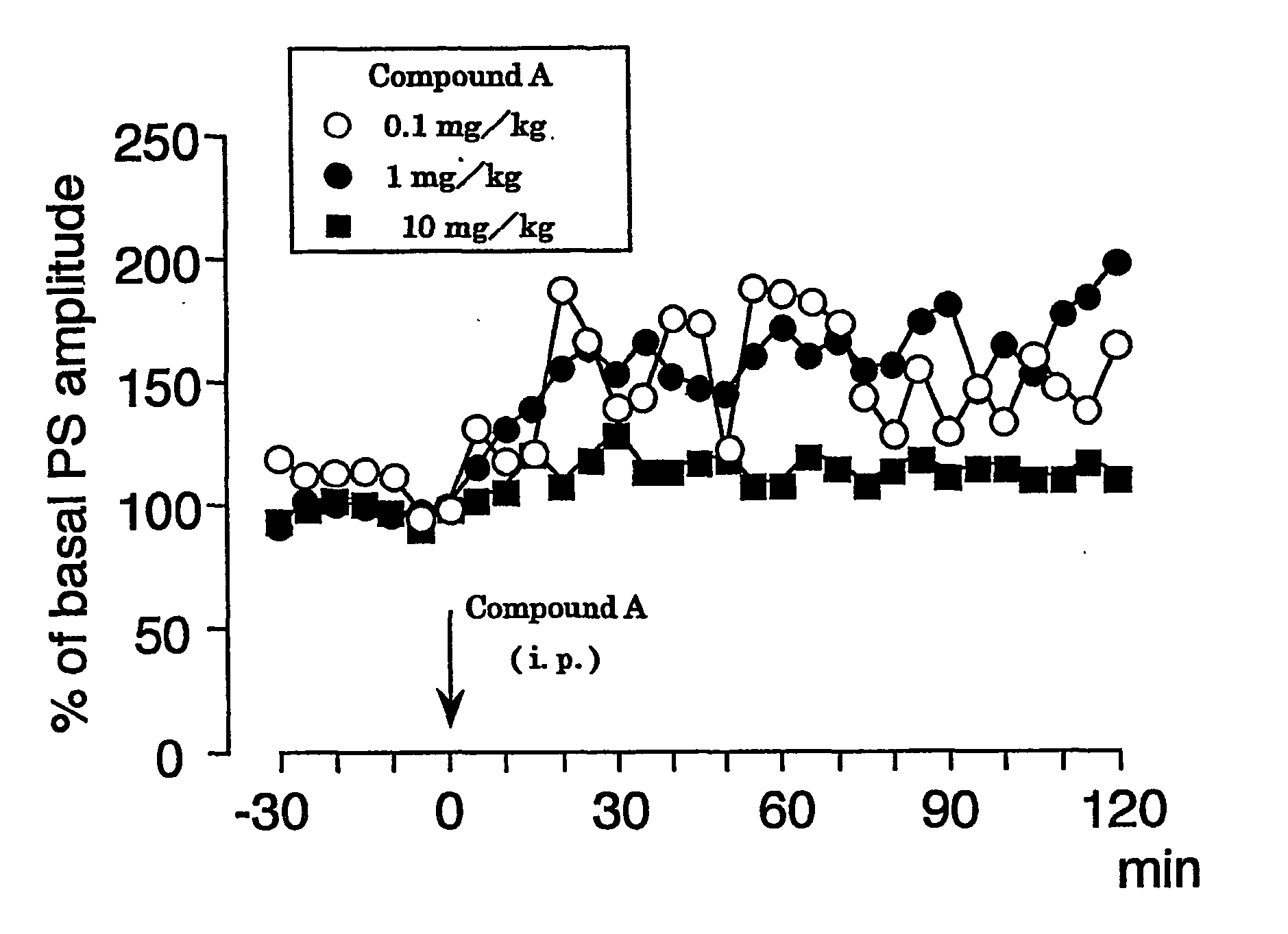Carboxylic acid compound cyclopropane ring
a carboxylic acid compound and cyclopropane ring technology, applied in the field of new carboxylic acid compounds and pharmaceuticals, can solve the problem of inability to achieve stable effect over a long period of time, and achieve the effect of stable ltp-like potentiation of synaptic transmission and slow metabolism
- Summary
- Abstract
- Description
- Claims
- Application Information
AI Technical Summary
Benefits of technology
Problems solved by technology
Method used
Image
Examples
experimental example 1
(1) Method
For population spike (PS) recording, the head of a mouse was fixed with ear bars under urethane anesthesia (an initial dose of 1.2 g / kg, i.p. followed by supplemental injections of 0.2-0.6 g / kg as needed), and a glass recording electrode was placed in the cell body layer of dentate granule cells (coordinates=2.0-2.5 mm posterior to bregma, 1.0-1.5 mm lateral to the midline, 1.5-2.0 mm ventral to the brain surface). Initial responses were obtained using cathodal stimulation (7.0-9.0 V, 0.1 Hz, 0.1 ms in duration) of the perforant path. After both stimulating and recording electrodes were properly positioned and population spike was obtained, the baseline was allowed to stabilize for 30 min prior to baseline recording. Body temperature was maintained at 37° C. Compound A was dissolved in 50% polyethylene glycol, diluted with water, and injected intraperitoneally (i.p.) at concentrations of 0.1 mg / kg, 1 mg / kg and 10 mg / kg, respectively. After the intraperitoneal administra...
example 1
(1) To a mixture of linoleic acid methyl ester (2.5 g) and dichloromethane (50 ml), a 0.99M solution of diethylzinc (103 ml) in n-hexane was added under a nitrogen atmosphere. The mixture was cooled in an ice-water bath (−5° C. to 0° C.) and stirred for 1 hour at this temperature. Diiodomethane (16.4 ml) was added to the mixture, and the mixture was stirred at ambient temperature overnight. After evaporation in vacuo of the solvent, the reacting mixture was dissolved in a mixture of ethyl acetate (EA) and a saturated aqueous solution of ammonium chloride. The separated organic layer was washed with water and dried over magnesium sulfate. After filtration, the filtrate was concentrated in vacuo. The obtained residue was purified by chromatography on silica gel (eluted with 1% EA in n-hexane). The fractions including 8-(2-((2-pentyl-cyclopropan-1-yl)methyl)cyclopropyl)octanoic acid methyl ester were collected and concentrated in vacuo to give 8-(2-((2-pentylcyclopropan-1-yl)methyl)cy...
example 2
(1) To a mixture of oxalyl dichloride (18.85 ml) and dichloromethane (60 ml), dimethyl sulfoxide (2.99 ml) was added under a nitrogen atmosphere. The mixture was cooled in an ice-water bath and stirred therein for 15 minutes. 9-Hydroxynonanoic acid methyl ester (2.00 g) was added to the mixture. The mixture was stirred for 1 hour and triethylamine (10.8 ml) was added to the reaction mixture. The reaction mixture was stirred for 1 hour at ambient temperature and poured into a mixture of ethyl acetate (EA) and a saturated aqueous solution of ammonium chloride. The separated organic layer was washed with water and dried over magnesium sulfate. After filtration, the filtrate was concentrated in vacuo. The obtained residue was purified by chromatography on silica gel (eluted with 5% EA in n-hexane). The fractions including 8-formylnonanoic acid methyl ester were collected and concentrated in vacuo to give 8-formylnonanoic acid methyl ester (1.69 g) as an oil.
1H-NMR (300 MHz, CDCl3) δ 1...
PUM
| Property | Measurement | Unit |
|---|---|---|
| Acidity | aaaaa | aaaaa |
| Transmission | aaaaa | aaaaa |
Abstract
Description
Claims
Application Information
 Login to View More
Login to View More - R&D
- Intellectual Property
- Life Sciences
- Materials
- Tech Scout
- Unparalleled Data Quality
- Higher Quality Content
- 60% Fewer Hallucinations
Browse by: Latest US Patents, China's latest patents, Technical Efficacy Thesaurus, Application Domain, Technology Topic, Popular Technical Reports.
© 2025 PatSnap. All rights reserved.Legal|Privacy policy|Modern Slavery Act Transparency Statement|Sitemap|About US| Contact US: help@patsnap.com



